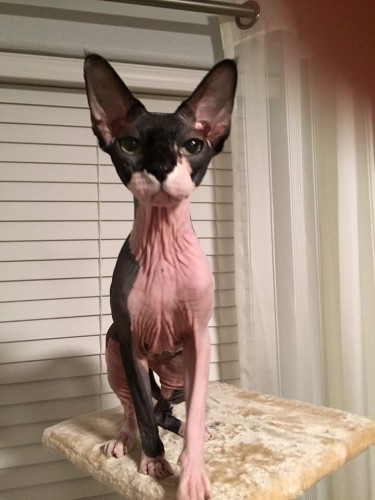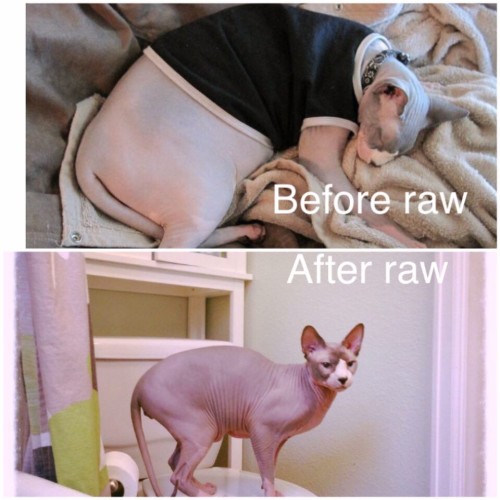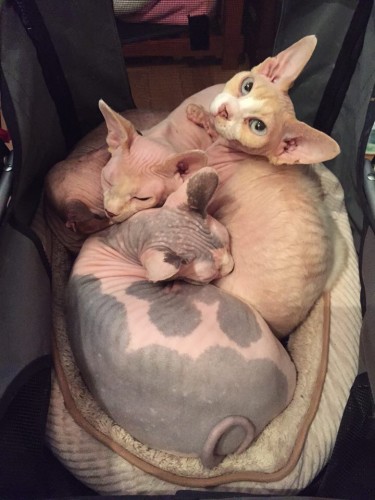This post is part of our “Journey to Raw” series, currently published every Wednesday, and comes to you from Dawn Sanchez, an outdoor enthusiast who indulges her passion by working to protect and conserve national forests.

Johnny
I started my journey to raw with an amazing Sphynx cat who had horrible diarrhea every day no matter what I did. He always cried before he went to the bathroom, I’m sure because it didn’t feel good for him. We tested for parasites and viruses, we tried expensive store bought food, cheap food, grain free, prescription food and everything in between. Nothing helped him. I have several friends who fed raw and they kept trying to tell me that I needed to go raw but as most people are, I was terrified of of the thought I might be putting my cats health at risk and giving them salmonella and e-coli. When I talked to my vet about going raw, I was told that it was a horrible idea and I would do more damage than good so I kept trying new foods. Nothing I did helped him and one night he climbed into bed with a poop covered tail and I decided no more, it was time to try something radical. I decided I would take the plunge and feed him raw.
I started reading. I learned the best way to transition was to go from kibble to canned food to raw. I was all set to go with transitioning to canned while I learned all I could about home prepping his raw food. I found a limited ingredient canned and when I offered it, he refused to eat it. In fact he refused to eat anything with a wet consistency, and I knew we were not going to get to raw easily. I started by mixing a small amount of wet into his dry. He refused to eat it. I tried to top it with more dry, and he ate the dry off the top. I finally tried just a dab of wet food in his dry and he finally ate it!! I continued to do this over about 6 weeks and slowly increased the dabs of wet so he didn’t notice a change. We did take a few steps back along the way but we eventually got there and he was eating 100% canned. I made my first batch of raw and started that slow transition and it took us about 4 weeks to make that switch. When we were about 75% raw to 25% canned, his poop started to firm up and it no longer stunk up the whole house. It worked!! Finally he was pooping normally and he was feeling so much better. He lost weight and he gained a tremendous amount of energy. He was not only doing well, he was thriving.

Diego
After I got Johnny on raw and saw the improvements it made in him, I wanted to try to transition Diego, my other Sphynx, but he had reoccurring issues with crystals in his urine. I was told he could only eat the prescription kibble food for the rest of his life or he would have issues with crystals again, risking a full blockage and potential surgery. My vet explained to me that the kibble he was on was higher in sodium which encouraged him to drink more water. In my head, I was not ok with him eating a high sodium food however I was assured there would be no long term negative effects. He loved his kibble, so much so he was overweight, and I had to resort to feeding him out of a puzzle dish in an attempt to control his weight. I decided to talk to the “raw feeders” about raw with urine crystals and again I was told raw would be the best thing I could do for him, so I transitioned him to canned and then to raw. Since he loved food, his transition was easy. Diego lost weight and also gained the energy that Johnny did. I have been feeding him raw for about 5 ½ years now and we have had no issues with crystals.
Johnny went on to develop a genetic heart disease called HCM. Johnny’s raw diet kept his body strong and healthy, while his heart wasn’t so healthy. When his heart started to fail and he went into congestive heart failure, he was on a lot of medication to clear his lungs of fluid and to keep his heart functioning as efficiently as it could. One of the major side effects of these medications is the toll it takes on a cat’s organs, especially the kidneys. It’s very common for a congestive heart failure kitty to suffer kidney damage from the medications. Johnny had to have blood work taken often to keep a current status on his organ function, and the cardiologist was always so happy to see that his organ function stayed at a normal level. This allowed us a lot of room to increase the medication as needed to keep him stable. I fully credit that organ stability to his diet keeping his body strong.

My naked boys. I love them so much!
All of my kitties are now raw fed and it has done amazing things in all of my Sphynx cats. Their skin is soft, they need baths less often, their ears have less “gunk” and the best part is the lack of smell in the litter box. My little Devon Rex kitten has soft and shiny curls and loves his diet!
Switching to a raw diet was the best thing I’ve ever done for my cats. I know it will keep my other HCM Sphynx cats stable as their disease progresses. I have found that I can make raw cheaper than I can buy a high quality food for them. Yes, it does take time to prepare but my cats are my kids and just like a parent would want their 2 legged child to have healthy prepared meals, I feel the same about my 4 legged children. It is more than worth it!
If you feed a home-prepared raw menu to your kitties and would like to see your story featured here, please contact us via private message through Facebook on our page or in our group or leave a comment below!
And if you’re interested in giving raw a try for yourself, check out our Raw Feeding and Transitioning Your Cat to Raw sections!

